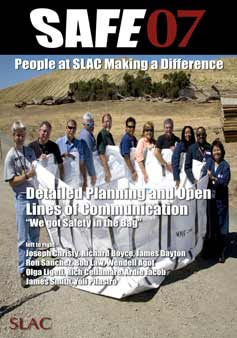
Handy Links
SLAC News Center
SLAC Today
- Subscribe
- Archives: Feb 2006-May 20, 2011
- Archives: May 23, 2011 and later
- Submit Feedback or Story Ideas
- About SLAC Today
SLAC News
Lab News
- Interactions
- Lightsources.org
- ILC NewsLine
- Int'l Science Grid This Week
- Fermilab Today
- Berkeley Lab News
- @brookhaven TODAY
- DOE Pulse
- CERN Courier
- DESY inForm
- US / LHC
SLAC Links
- Emergency
- Safety
- Policy Repository
- Site Entry Form

- Site Maps
- M & O Review
- Computing Status & Calendar
- SLAC Colloquium
- SLACspeak
- SLACspace
- SLAC Logo
- Café Menu
- Flea Market
- Web E-mail
- Marguerite Shuttle
- Discount Commuter Passes
-
Award Reporting Form
- SPIRES
- SciDoc
- Activity Groups
- Library
Stanford
Around the Bay
Safety Success Story: "We Got Safety in the Bag"
 Where there's thoughtful communication and collaboration about safety, there's often a safety success story. For last month's SAFE07 feature story—the Final Focus Test Beam (FFTB) preservation project—the formula was no different. This month, we focus specifically on how collaboration between LCLS and the Environment, Safety and Health (ES&H) Division supported the project's safety goals.
Where there's thoughtful communication and collaboration about safety, there's often a safety success story. For last month's SAFE07 feature story—the Final Focus Test Beam (FFTB) preservation project—the formula was no different. This month, we focus specifically on how collaboration between LCLS and the Environment, Safety and Health (ES&H) Division supported the project's safety goals.
"Many groups all worked together on this project to do it, do it safely, and do it following regulations," said Linac Coherent Light Source (LCLS) Senior Field Construction Manager Bob Law. "Every individual helped with the project's success, but in particular the support of ES&H helped us meet our zero safety incidents goal."
ES&H worked closely with LCLS workers and contractors to integrate itself into the project. They worked with the other groups to plan, schedule and choreograph activities, and ensure that safety controls were enforced at all times. Daily safety meetings also helped keep everyone apprised of all the different activities planned for a given day.
"We all worked together to stay safe and get the job done," said Radioactive Waste Group Leader Olga Ligeti. "We adhered adamantly to the 'Safety First' motto."
From start to finish, ES&H personnel were on the FFTB job site to support the LCLS team and its various contractors. They were among the very first on the job site, setting up safety control systems. And they were among the very last to leave, making sure they left the research yard contamination free. By integrating themselves into the whole of the project, ES&H waste management personnel facilitated the quick and safe removal of the FFTB.
"It was their job site, but we were there at all times as support to make sure that waste management and radiation safety went smoothly and safely," said Waste Management Section Leader Yoli Pilastro.
The ES&H team's first major task was to sample the job site for radiation before any construction workers were allowed into the area. By testing concrete and soil samples at strategic locations around the site, the Radiation Protection team was able to determine the regions which posed a radioactive contamination hazard. They then cordoned off those areas and applied plywood barriers to prevent workers from passing between them. The plywood was lined with plastic to keep the contamination off the plywood, thereby minimizing contaminated waste. To keep the dust from the excavation from becoming airborne, a fine water mist was applied during the process.
The ES&H team then worked with the LCLS project managers and field operators to determine the proper personal protective equipment, required training, and dosimetry required for each zone.
"This clear demarcation and the strict enforcement of control requirements in each area helped ensure safety on the job site," said Ligeti.
As the project progressed, the ES&H Radiation Protection Group performed quality assurance radiation measurements for all waste excavated from the site, no matter which zone it came from. Through the ES&H Waste Management Group, the team also packaged all waste soils determined non-radioactive—approximately 400 cubic yards of it—in 20-cubic yard bins, which were then transported to a well-controlled landfill near Livermore, California. As waste was unearthed from the FFTB and surrounding areas, it was immediately packaged so that there would be no chance of spread of contamination.
After LCLS workers and contractors had removed the entire FFTB installation, the ES&H Waste Management and Radiation Protection Groups stayed on site to oversee the removal of several feet of soil beneath the building's foundations. In areas of higher radiation contamination, soil up to six feet deep was removed. On average, a depth of two feet was all that had to be removed.
The packaged radioactive concrete and soil was quickly removed from the site and sent to a secure disposal facility for radioactive and mixed wastes in Utah. In total, the Radioactive Waste Group shipped 92 bags of concrete and soil over the course of three weeks without a single safety incident.
"It's very fulfilling to help make a project like this have a successful, on time, and safe conclusion," said Pilastro. "We look forward to helping with other projects in the future."
—Kelen Tuttle, SLAC Today, August 28, 2007